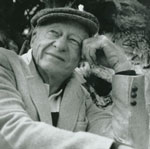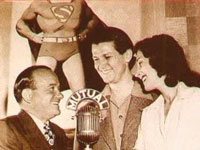Jim Crow Museum
1010 Campus Drive
Big Rapids, MI 49307
[email protected]
(231) 591-5873
Did you know that Superman was instrumental in bringing down the Ku Klux Klan of the 1940s?
-- Chapin Kellogg - Nolfork, Virginia

I am pleased that you asked this question because it gives me an opportunity to talk about one of my favorite writers and civil rights activists, Stetson “Stet” Kennedy. In the 1930s he was Director of Folklore, Oral History and Ethnic Studies for the Florida Federal Writers Project. One of his colleagues was Zora Neale Hurston, the famed novelist and anthropologist. In the 1940s the United States was fighting Nazism in World War II, but because of a back injury, Kennedy was unable to join the military. He satiated his desire to fight injustice, though, by infiltrating the Ku Klux Klan, a domestic Nazi-like terrorist organization. He joined the Georgia Klan at the behest of the Georgia Bureau of Investigation; he would later come to not trust these law enforcement personnel. The information that he uncovered was reported in his books Southern Exposure (1946), and The Klan Unmasked (originally published as, I Rode With the Ku Klux Klan in 1954). In these books, he used eyewitness data to undermine the racial terrorists who used violence to enforce local Jim Crow laws and customs.
In The Klan Unmasked, Kennedy described a heroic tale where he, posing as a racist encyclopedia salesman named John S. Perkins, infiltrated a Klan organization in Atlanta, Georgia. Risking his life, he donned the Klan hood and robe, burned crosses, gave racist speeches, and clandestinely collected information about Klan activities. He rose to the position of Klavalier, a person expected to exercise force or violence, the equivalent of a Mafia strongman. His wrist was slit with a jackknife and he swore a blood oath: “Klansman, do you solemnly swear by God and the Devil never to betray secrets entrusted to you as a Klavalier of the Klan?” Thankfully, Kennedy violated this oath. The Klan Unmasked contained what one would expect — information about secret Klan rituals and activities—but its other value lay in the connection that Kennedy made between the Klan and the values held by “mainstream” citizens. Klansmen saw themselves as God-fearing, law-abiding lovers of patriotism. In their minds they were the true Americans and many White Americans sympathized with their goals if not their methods. Klan members and allies included politicians, business leaders, journalists, ministers, and police officers. Klan supporters crossed political party lines, including the infamous Talmadge family political machine (Democrats) who rode Klan support to national prominence, and Republican business leaders who used the Klan to bust unions, one head at a time. In contemporary America, the Klan is seen by most people as an embarrassing relic of this country’s racist past. But in the 1940s and 1950s, there were many Americans who openly supported the Klan’s objectives. For example, Congressman John Rankin of Mississippi, Chair of the House Un-American Activities Committee, opposed investigating the Klan because, “After all, the KKK is an old American institution." His colleague, Congressman John S. Wood of Georgia, added, "The threats and intimidation of the Klan are an old American custom, like illegal whiskey-making."

Kennedy sent the evidence he gathered to prosecutors, politicians, journalists, human rights organizations, and anyone else who he thought might disseminate the information. This was risky. He had no foolproof way to know if the recipient of the damning information was not himself or herself a Klan sympathizer. Kennedy found an ally in Andrew Russell Pearson, a popular muckraking journalist and radio host, known professionally as Drew Pearson. For a time in the 1940s, Pearson read the minutes from Klan meetings on his national radio show. This was devastating to the Klan. The minutes included the names of prominent citizens who had attended Klan meetings and rallies. Among the list of names were both pillars of the community who did not mind being identified with the KKK, and those who were embarrassed to have their names publicly linked to Klan activities. In part as a result of this public attention, Klan membership started to decrease. Kennedy also contacted Robert Maxwell, the producer of the Adventures of Superman radio show and pitched the storyline of Superman versus the Ku Klux Klan. It was not a hard sell. World War II had ended and the fictional Superman had defeated Hitler, Mussolini, Hirohito and their followers. The Man of Steel needed new foes. The writers created “Clan of the Fiery Cross,” a series where Superman battled the Klan. Kennedy and the show’s producers recognized that the Klan thrived on secrecy. By revealing everything from local Klan gossip to the Klan’s organizational structure and code words, the program stripped the Klan of its air of mystery and hurt Klan recruiting and membership.
Editor's Note: Download the original “Clan of the Fiery Cross” radio program in MP3 format.

“Doc” Green, a Grand Dragon in the Atlanta, Georgia Klan, was furious that the KKK’s
secrets were being shared and trivialized on a national radio show. He ranted. He
threatened a local boycott of Pep Cereal — sponsors of the Adventures of Superman. And, not surprisingly, he placed a bounty on the “unknown rat.” Kennedy traveled
with a Smith and Weston 32 automatic in a shoulder holster.
Why would Kennedy, bred into an aristocratic southern family, turn his face away from the southern racial caste system? The answer may have much to do with his ancestry, which included two men who signed the Declaration of Independence, a Confederate Army officer, and John Batterson Stetson, the founder of the hat empire and the man for whom Stetson University is named. His family also included “Brady,” an uncle who had been a Klan official, a “Great Titan,” the head of a congressional district. Thus, Kennedy's lifelong fight against racism and racist groups may have been fueled by notions of family redemption. More likely, however, his willingness to risk his life and social standing was motivated by his relationship with a woman known only as Flo.
When Kennedy was a little boy, it was common for wealthy Southern families to have Black maids. Flo was not only a maid to the Kennedys but, in his words, “almost like a mother” to him. Flo violated Jim Crow etiquette by questioning a White bus driver who refused to give her correct change. For the crime of “talking back to a White person” she was tied to a tree, beaten, and raped by a gang of Klansmen. This tragic and horrific incident showed the young Kennedy that the Klan, though they claimed to be Christian patriots, were really criminals capable of great savagery.
I would be remiss if I did not mention that Kennedy had a great many detractors and critics. In some instances, the criticism was born of pro-Klan sympathies; however, there is a criticism that is not so easy to dismiss. In the last decade, a number of writers, most prominently Stephen J. Dubner and Steven D. Levitt, the authors of Freakonomics: A Rogue Economist Explores the Hidden Side of Everything (2005) have criticized Kennedy. Their book includes a chapter called, "How Is the Ku Klux Klan Like a Group of Real-Estate Agents?" That chapter chronicles the heroism of Kennedy. However, a year later they questioned if Kennedy’s writings, especially The Klan Unmasked, were more fictional than real. What changed their appraisal of Kennedy? The answer? Ben Green.
In 1992, Ben Green began conducting research for a book about Harry T. Moore and Harriette Vyda Simms Moore, two civil rights workers murdered by White supremacists. Initially, Kennedy collaborated with the project. Green wanted to use some of the information that Kennedy uncovered during his infiltration of the Klan. He went to the Schomburg Center in Harlem, New York (where Kennedy had donated his papers). Apparently, this is when the problems started. Green claimed, after months of readings Kennedy’s field notes, that he was unable to substantiate many of the claims in The Klan Unmasked. He even insinuated that Kennedy had fabricated his true role. In recent years, Kennedy now in his 90s has been fighting to salvage his reputation and protect his legacy. He acknowledged that some accounts in his books were actually derived from the actions of co-infiltrators or others sympathetic with undermining the Klan. Though I recognize the importance of integrity in a person's work, I am nevertheless not especially troubled if Southern Exposure or The Klan Unmasked includes accounts from others afraid to speak for themselves. Nor am I bothered that Kennedy embellished his role. Infiltrating the Klan was an act of great courage, and the information in the books and on the radio shows led to the arrests of some Klansmen, the derailing of domestic terrorist acts, and the unpopularity of the Klan organization. That is good enough for me. I encourage readers to watch this short video which chronicles the life and work of Kennedy: https://www.youtube.com/watch?v=mr9S3crx9Lc.
The Jim Crow Museum staff periodically trains docents to work in the facility. When I facilitate this training I have the students read Kennedy’s book, Jim Crow Guide: The Way It Was (1959). The book is a mock guide dripping with bitter sarcasm; nevertheless, it is a historically sound account of life under Jim Crow segregation. If you would like to read the book "Jim Crow Guide" online please visit, http://www.stetsonkennedy.com/jim_crow.html.
July 2009 response by
David Pilgrim
Curator
Jim Crow Museum